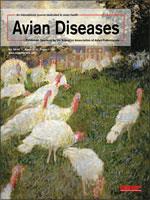Ornithobacterium rhinotracheale (ORT) is a nonhemolytic, gram-negative, pleomorphic, rod-shaped bacterium that causes upper and lower respiratory tract disease in poultry. Recently, hemolytic strains of ORT have been isolated with increasing frequency from field outbreaks. A study was conducted to determine whether the hemolytic phenotype is associated with any change in virulence. Briefly, 225 turkey poults, vaccinated against hemorrhagic enteritis at 4 wk of age, were randomly divided into nine replicates housed in separate rooms: three sham treatment controls (25 poults/replicate), three challenged with a nonhemolytic (NH) field isolate (24 poults/replicate), and three challenged with a hemolytic (H) field isolate (24 poults/replicate). Nine days postvaccination, poults were inoculated intratracheally with either 0.2 ml sterile phosphate-buffered saline (PBS), 2 × 108 colony-forming units (CFU) of the NH isolate in 0.2 ml PBS, or 2 × 108 CFU of the H isolate in 0.2 ml PBS. Serum and body weights were obtained at 0, 7, 14, and 21 days postinoculation (dpi). Tissues were taken for culture and histopathology from five randomly selected poults/replicates at 7, 14, and 21 dpi. When compared with poults inoculated with the H isolate or controls, those inoculated with the NH isolate showed a highly significant depression in weight gain at 7 dpi. NH poults also had significantly higher levels of antibody against ORT at 14 and 21 dpi. Reisolations decreased over time and, by 21 dpi, only the NH phenotype could be found. Based on a Likert-type scale, poults inoculated with the NH isolate had significantly higher histopathologic lesion scores in lung tissue at 7, 14, and 21 dpi. Results suggest that nonhemolytic field isolates are more virulent then hemolytic ones. These findings are unusual because hemolytic phenotypes are often more virulent in other bacterial species.
Comparación experimental In Vivo de aislamientos de campo hemolíticos y no hemolíticos de Ornithobacterium rhinotracheale.
Ornithobacterium rhinotracheale (ORT) es una bacteria no hemolítica, pleomórfica, gram-negativa en forma de bacilo que causa enfermedad del tracto respiratorio superior e inferior en aves comerciales. Recientemente, se han aislado cepas hemolíticas de ORT asociadas con aumento de la frecuencia de los brotes en campo. Se realizó un estudio para determinar si el fenotipo hemolítico se asocia con cualquier cambio en la virulencia. Se utilizaron 225 pavipollos, vacunados contra la enteritis hemorrágica a las 4 semanas de edad, que fueron divididos aleatoriamente en nueve réplicas alojadas en unidades separadas: tres controles (25 pavitos/replica), tres unidades desafiadas con un aislamiento de campo no hemolítico (Grupo NH) (24 pavipollos/réplica), y tres unidades desafiadas con un aislamiento de campo hemolítico (Grupo H) (24 pavipollos/réplica). Nueve días después de la vacunación, los pavipollos fueron inoculados por vía intratraqueal, ya sea con 0.2 ml de solución salina estéril amortiguada con fosfato (PBS), o con 2 x 108 unidades formadoras de colonias (UFC) del aislamiento no hemolítico en 0.2 ml de PBS, o con 2 × 108 UFC del aislamiento hemolítico en 0.2 ml de PBS. Se obtuvieron muestras de suero y se registraron los pesos corporales a los 0, 7, 14, y 21 días después de la inoculación (dpi). Se recolectaron muestras de tejidos para cultivo y para histopatología de cinco pavos seleccionados aleatoriamente por réplica a los 7, 14 y 21 días después de la inoculación. Cuando se compararon con los pavipollos inoculados con la cepa hemolítica o con los controles, las aves inoculadas con el aislado no hemolítico mostraron una depresión en la ganancia de peso altamente significativa a los 7 días postinoculación. Los pavipollos inoculados con la cepa no hemolítica también mostraron niveles significativamente m





